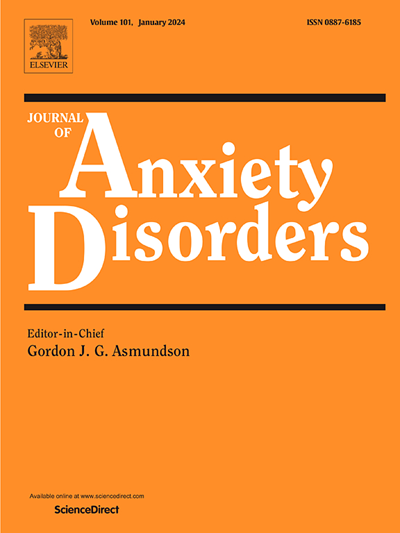Exposure therapy consortium: Outcomes of the proof-of-principle study
IF 4.8
2区 医学
Q1 PSYCHIATRY
引用次数: 0
Abstract
Background
This paper reports on the outcomes of a proof-of-principle study for the Exposure Therapy Consortium, a global network of researchers and clinicians who work to improve the effectiveness and uptake of exposure therapy. The study aimed to test the feasibility of the consortium’s big-team science approach and test the hypothesis that adding post-exposure processing focused on enhancing threat reappraisal would enhance the efficacy of a one-session large-group interoceptive exposure therapy protocol for reducing anxiety sensitivity.
Methods
The study involved a multi-site cluster-randomized controlled trial comparing exposure with post-processing (ENHANCED), exposure without post-processing (STANDARD), and a stress management intervention (CONTROL) in students with elevated anxiety sensitivity. Feasibility was assessed using site performance metrics (e.g., timeline, sample size, missing data). Efficacy was assessed up to 1-month follow-up using the Anxiety Sensitivity Index-3.
Results
Despite challenges posed by unforeseen global crises, a standardized protocol for screening, assessment, and treatment at 12 research sites across four continents was successfully implemented, resulting in a total sample size of 400 with minimal missing data. Challenges in recruitment and adherence to the projected timelines were encountered. Significant reductions in anxiety sensitivity were observed in all conditions. Contrary to hypotheses, group differences were only observed at post-treatment, when ENHANCED and CONTROL outperformed STANDARD but were not significantly different from each other.
Conclusions
This study demonstrates the feasibility of the Exposure Therapy Consortium. Findings raise questions regarding the efficacy of large group exposure interventions and underscore the importance of careful research site selection and an iterative approach to treatment development.
暴露疗法联合:原理证明研究的结果。
背景:本文报道了暴露疗法联盟的一项原理证明研究的结果,暴露疗法联盟是一个致力于提高暴露疗法有效性和吸收的研究人员和临床医生的全球网络。本研究旨在验证该联盟的大团队科学方法的可行性,并验证一个假设,即增加以增强威胁重新评估为重点的暴露后加工,将提高单期大群体内感受性暴露治疗方案降低焦虑敏感性的效果。方法:本研究采用多地点集群随机对照试验,比较有后处理暴露(ENHANCED)、无后处理暴露(STANDARD)和压力管理干预(CONTROL)对焦虑敏感性升高学生的影响。可行性评估使用现场性能指标(例如,时间线,样本量,缺失数据)。随访1个月后使用焦虑敏感性指数-3评估疗效。结果:尽管面临不可预见的全球危机带来的挑战,但在四大洲的12个研究地点成功实施了一项标准化的筛查、评估和治疗方案,总样本量为400,数据缺失最少。在征聘和遵守预计时间表方面遇到了挑战。在所有情况下都观察到焦虑敏感性的显著降低。与假设相反,组间差异仅在治疗后观察到,此时ENHANCED和CONTROL优于STANDARD,但彼此之间没有显著差异。结论:本研究证明了暴露治疗联盟的可行性。研究结果提出了关于大群体暴露干预的有效性的问题,并强调了仔细研究地点选择和治疗开发迭代方法的重要性。
本文章由计算机程序翻译,如有差异,请以英文原文为准。
求助全文
约1分钟内获得全文
求助全文
来源期刊

Journal of Anxiety Disorders
Multiple-
CiteScore
16.60
自引率
2.90%
发文量
95
期刊介绍:
The Journal of Anxiety Disorders is an interdisciplinary journal that publishes research papers on all aspects of anxiety disorders for individuals of all age groups, including children, adolescents, adults, and the elderly. Manuscripts that focus on disorders previously classified as anxiety disorders such as obsessive-compulsive disorder and posttraumatic stress disorder, as well as the new category of illness anxiety disorder, are also within the scope of the journal. The research areas of focus include traditional, behavioral, cognitive, and biological assessment; diagnosis and classification; psychosocial and psychopharmacological treatment; genetics; epidemiology; and prevention. The journal welcomes theoretical and review articles that significantly contribute to current knowledge in the field. It is abstracted and indexed in various databases such as Elsevier, BIOBASE, PubMed/Medline, PsycINFO, BIOSIS Citation Index, BRS Data, Current Contents - Social & Behavioral Sciences, Pascal Francis, Scopus, and Google Scholar.
 求助内容:
求助内容: 应助结果提醒方式:
应助结果提醒方式:


